by Winding Pathways | May 9, 2017 | Flowers/Grasses, Nature, Trees/Shrubs, Wonderment
We invited readers of Winding Pathways blogs to submit a photo and short description of a favorite spring scene. The response spanned from the Pacific Northwest to Canada and from the Desert Southwest to New England. Enjoy readers’ reflections on our emerging spring. The essays appear as they came in to Winding Pathways. Thank you all for your charming observations. Happy Spring! And soon, welcome summer.
***
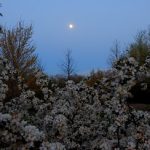
“Every year I wait for our Sargentina crab apple trees to bloom.”
As much as I love our native prairie plants and various garden inhabitants, every year I wait for our Sargentina crab apple trees to bloom. Not too long ago, in the company of one of our barn cats, I sat out on the patio and watched the full moon rise with the sweet smell of the flowers drifting over. Bees lay full claim to the blossoms during the day, from the little sweat bees to the bumbles, so I try to give them some space and wait until evening before diving nose-first into the branches myself.
Emily Groom Hemmerling, Kansas
***
Here in NH, spring is slowly unfolding. The barred owls are getting amorous and I’ve heard, although not seen, “our” hawks. There’s a barn swallow that’s building a nest under the eaves, and the bear visited the other night. The weather seems to be lacking any nuance. We are alternating between two or three days of cold, windy, rainy (tell the truth–nasty) days and occasional beautiful sunny days in the ’70s.
Waiting is hard after a long winter, but change should accelerate very soon. The hummingbirds return on average on May 11th, and by then many flowers should be in bloom and the trees that are barely budding today will be fully green. This time of year Carly Simon is often on my mind–“Anticipation”. Sue Fehsinger, New Hampshire
-
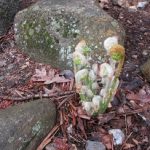
-
Unwinding slowly, fiddle head ferns appear mysteriously.
-
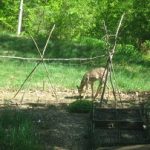
-
Deer In Garden
-
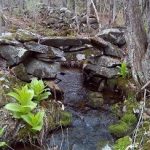
-
A New Hampshire springtime brook graced with Skunk Cabbage.
-
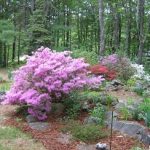
-
A splash of color!
***
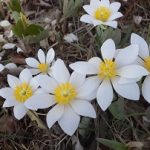
Dazzling white petal surround deep yellow centers.
These Bloodroots are found at the western end of our road. We have now lived on this road for 17 years and have watched the progression of growth and expansion each year of more and more desirable plants. The area has become a huge carpet of white under all the trees. The blossoms on the north side of the road show their faces first and a few days later the blossoms on the south side of the road appear. Since we have been here, each year it has been the same blooming schedule. We also have Bloodroots in our yard which don’t appear until the ones on the road seem to be in full bloom. They are only 1/4 mile apart.
I photographed this forsythia at the edge of our neighbor’s property. I do not have any on our property. It was a beautiful sunny day and the yellow of the blossoms was brilliant. I was also trying to get a different angle on the blossoms, rather than the whole bush.
My purple hyacinths are still producing blooms in my small north facing garden. This year they seemed to have a deeper purple color and more blossoms on the stock.
The Virginia bluebells are now blossoming. I counted 16 clumps of them in a small area at the top of our dry kettle. I am even finding small self-seeded plants.
We are privileged to see wood ducks in our channel in the early spring. They are very skittish and it is difficult to sneak up on them to get a photo. We see them for a short time and then they disappear until next year. Sue Hrobar, Wisconsin
-
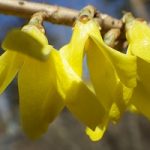
-
Like gold the flowers shine.
-
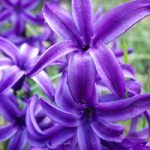
-
Beautiful Purple Blossoms
-
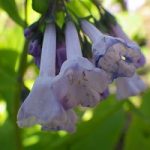
-
Close-up view
-
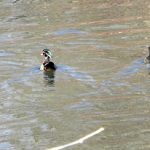
-
Searching for the right home.
***
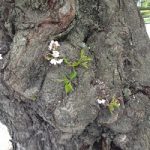
The ancient tree sprouted leaves and flowers all over.
I walked this Chestnut Hill neighborhood in Boston often while living and working in the area. My first fall a few heavily gnarled trunks of a handful of trees planted in the boulevard strips particularly captivated me. These trunks reminded me of Italian grandmothers; stout, sturdy, not particularly tall, deeply wrinkled and absolutely beautiful. When spring arrived I was amazed to see how blossoms not only appeared in their canopies but also sprang from their very bark. I loved these elderly trees all the more and saw them as clothed from head to toe in spring attire. May all of us exhibit such beauty and grace as we mature. Adria J, Illinois and Maine
***
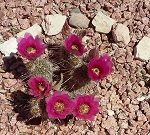
The desert Southwest alive with color.
Here is my first cactus bloom of the season! Soon my yard will be bursting with color, from all of the different cacti!
Coming from the Midwest, this is such a different sort of pretty. Most of the year it is dry and barren up here in the high desert. These little bursts of color that pop up in the spring are such a delight! I love to walk in my neighborhood and see all of the different blooms. We have a very mild winter and sometimes it’s hard to tell that spring is here, at least for this Midwestern gal. The flowers alert me that spring has indeed arrived! Such a contrast to these prickly little fellows. Add to that the brilliant green of the trees, looking almost iridescent, and the scent of the roses that pop up everywhere, I would say that spring is my
favorite season here. Deb Karpek, Arizona
***
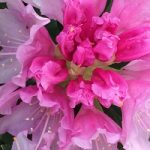
A close up of a western Rhododendron.
After the daffodils and the flowering trees fade is time in the Pacific Northwest for our native rhododendron to flower. They grow wild on the coast, but also are prized in yards because their large leaves are green all winter. Found growing wild near Port Discovery on the Washington coast in 1792 by Archibald Menzies who was with George Vancouver, it has been a favorite ever since. Officially it has been the Washington state flower since 1995, but women in 1893 designated it as such for a Worlds Fair that year. The rhododendron pictured is the Washington Centennial rhododendron from 1989. I love the way the blooms start out bright pink and fade to a pale pink as they open.
Jocelyn Berriochoa, Washington state
***
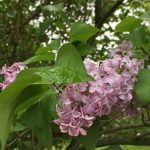
Raindrops on lilacs.
I opened the door this morning and looked out to see our lilacs blooming; pretty as could be. I thought, “Thank you, Grandma, for planting them over seventy plus years ago.” What a special way to start the day and welcome some of the beauty of spring. Claire Patterson, New Jersey
***
Spring came early to Bedford, Virginia, this year by about three weeks which means farmers, orchardists and gardeners began planting and hoping for early crops. Then to their surprise, we had two serious freezes back-to-back in March. The orchardists were especially chagrined because peaches, pears and apples took a hit. Watch for rising fruit prices.
As a gardener, it was thrilling to clean out the flowers and raised vegetable beds early on. As I began checking the asparagus patch, I noticed two silvery milkweed spears poking their heads through the soil next to the asparagus. They had begun their quiet vigil for the returning Monarch butterflies. I know the Monarchs have reached their most northern breeding grounds. However, I’ve not seen one returning Monarch here at the Ridge House.
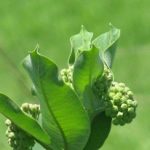
Milkweed is an important plant for Monarchs and other pollinators.
How did the milkweed come to be in my asparagus bed? There are a number of possibilities. Perhaps the birds deposited the seeds long ago. Or, the wind may have blown these wispy silky pinwheels into the patch. Another thought occurred to me that the seeds may have been tangled in the straw I scattered in the patch to help hold moisture through the dry summer months. However the seeds arrived, they are a God send as unthinking highway department mowers clear the roadsides, or a farmer applies toxic weed killer, or a home owner wanting a pristine lawn shears them off. The end result is far fewer pollinators like Monarchs and other butterflies, bees, and even birds. Where am I going with this you ask? This sage says, “All my weeds are wildflowers.” Peace. Jackie Hull, Virginia
***
-
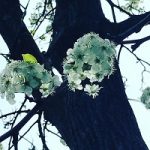
-
Spring in NYC
-
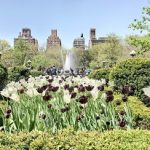
-
New York City is awash with soft color in the spring.
Spring in New York City. Dan Patterson, New York
***
Snow is melting gradually this spring. And, despite the string of rainy days lately, at the end of April we still had mounds of it around the house and in the woods.
The slow melt has meant that I’ve kept up with yard cleanup and, while trimming around the edge of the yard, I have come across early gems, like the bright purple crocuses with their eye-popping yellow-orange stamen, nestled among moss covered rocks near the path into the woods.
Elsewhere, along the edge of the woods, the early Spring ground cover, known as ‘William & Mary’, is starting to show its pink and blue blossoms. (I think of my patch as ‘Will & Kate’.)
And, I uncovered the little pile of beach stones that granddaughter Cadence assembled one summer.
Every Spring is different and every day brings different discoveries and possibilities in the garden.
Now, I’m headed out and about to see what new stuff is uncovered before the heavy rains come. I’m thankful we live outside the flood zone, but Fredericton will see another 100 year flood this weekend I fear. Lucy Fellows, New Brunswick, Canada
-
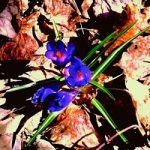
-
Poking through the leaves is a burst of color.
-
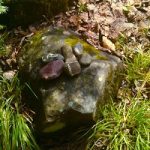
-
A stack of pebbles.
-
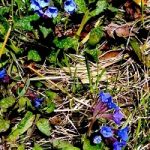
-
Early spring arrival
by Winding Pathways | Apr 25, 2017 | Flowers/Grasses, Nature, Wonderment
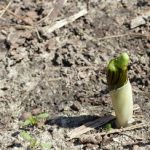
Tightly wrapped Mayapple pushes through the early spring ground.
Early each spring we look forward to the appearance of hundreds of Mayapples in our small woods. They appear like magic, usually after a few warm April days. Only a couple of days after their first shoots poke through the ground our woods are carpeted with umbrella-like Mayapple leaves.
It’s too bad that the Mayapple is misnamed. In most parts of its range, from Florida to Quebec and west to the Great Plains, it starts growing in early spring, flowers in May, and produces “apples” in June or early July. So, perhaps it should be called Mayflower or Juneapple.
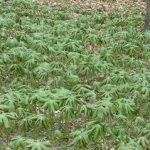
Mayapples populate open slopes.
Mayapples love living in the dappled sunlight in open forests. They spread by rhizomes and occasionally creep out into sunny areas and into deeper, darker woods. One of the delights of this plant is how easy it is to identify. No other North American wildflower sports the large umbrella like leaves that often appear in large patches.
When we look closely at our Mayapple patch we notice that most are leafy umbrellas rising on a single stalk while some are forked with a stem that splits like a “Y” and sporting two umbrellas.
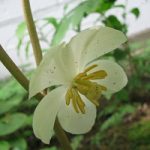
Beautiful blossoms hide under the umbrella-like leaves.
In May, these double leafed stems each grow one gorgeous but easy to miss white flower that’s usually pollinated by bumblebees. The flowers are easy to miss, because they are shaded by the large leaves.
The flower grows into a green fruit that looks like a mini lemon. It gradually turns yellow as it ripens.
All parts of this plant are toxic including the green fruit. However, once the fruit turns yellow it becomes edible and may people enjoy its custard-like fruit. But, be cautious. If eating it for the first time just enjoy a tiny portion of the yellow fruit to make sure it agrees with your system. Always be certain your identification is correct. A reliable source of information on many plant species, including Mayapple is United States Department of Agriculture, Natural Resources Conservation Service. Enter the name of the plant being sought, using either common or scientific name.
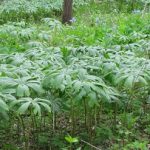
Mayapples spread by rhizomes.
Mayapples create a beautiful ground cover in open woods. They are easy to establish. Dig a few roots from a large patch and plant them under the trees. They’ll spread by rhizome.
by Winding Pathways | Apr 22, 2017 | Birds, Flowers/Grasses, Nature, Trees/Shrubs, Wonderment

Beautiful blossoms hide under the umbrella-like leaves.
First submission in! Hey all, on Facebook Winding Pathways invited folks to submit a favorite spring photo – tree, scene, flower, animal – with a short write-up of why you like that picture. And, Kansas readers Emily and Zach Hemmerling have already replied! Way to Go!
Now, I’d love to have about a dozen more so send them in to our email and I’ll continue processing and then post. These samples of spring pictures. Join in the fun and share your descriptions!
-

-
Photo – Protective custody
-
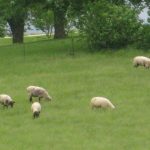
-
Photo of sheep in pasture
-
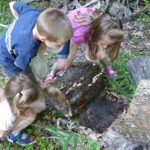
-
Kids develop strength, cooperation, and curiosity as they explore outside.
-
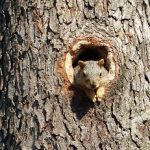
-
It’s a long way down, Mom.
-
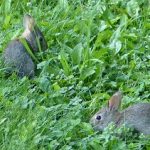
-
Bunnies are on their own as soon as the mother weens them.
-
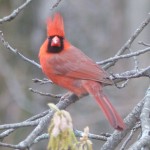
-
Photo – On a wild and windy day this Cardinal sang out his love song.
-
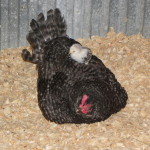
-
This mama hen with chick on her back fluffs up clean wood chips.
-
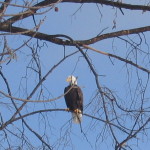
-
Eagle watching over nest.
-
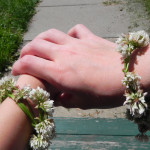
-
Clover bracelets
by Winding Pathways | Mar 21, 2017 | Birds, Nature, Wonderment
We’re lucky to have a pair of bald eagles nesting within walking distance of our home. Occasionally we clamber through the woods to check on the couple, but we’re careful to not disturb them. We stay a hundred yards away from their nest tree and spy on them through binoculars.
On March 12 Rich witnessed a remarkable trait of eagle parentage. Incubation is a female task with most birds. The male rarely sits. Not so with bald eagles. The soon-to-be father helps keep the eggs warm. Rich happened to be near the nest during the changing of the guard.
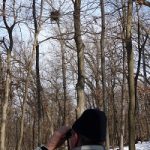
Watching from a distance.
He could see just the white crown of the sitting eagle’s head protruding from the huge nest built high in a white oak tree. Its mate perched on a limb about 50 yards away. Suddenly the sitting bird climbed off the eggs, spread its wings, and began circling the nest. Its mate joined the circling. After a few revolutions around the nest the recently sitting bird made a beeline north, presumably to look for dinner. The remaining eagle circled a few more times before settling down on a branch near the nest. After a minute or two it hopped into the nest and settled down over the eggs.
Who was who? Male and female bald eagles look alike, so Rich couldn’t tell if the male or female was the first incubator. It doesn’t really matter. Cooperation between the two is fascinating as this link shows.
Eagle parentage is an exercise in teamwork. The pair built the nest, take turns incubating, and both hunt for nestling food.
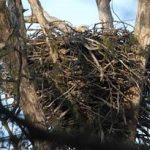
Eagles share parenting duties. Photo by M. Norlander
Eagle nests are becoming more common everywhere. The birds mostly feed on fish, so likely nest locations are near rivers, lakes, or the ocean. Nests are enormous piles of sticks, usually high in a tree and easy to spot. Bald eagles don’t seem bothered by roads, stores, or houses and often nests are within sight of heavy human activity.
Find a nest, dress warmly and sit some distance away with a pair of binoculars. You’ll be treated to examples of outstanding parentage. We plan to spy on our local eagle pair from a distance through the 35-day incubation period and as they raise their chicks.
by Winding Pathways | Mar 9, 2017 | Labyrinths, Wonderment
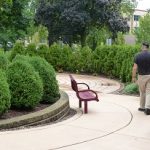
Set next to a busy sidewalk yet, discreet in location.
The world seems stressed now and yet, the tools we can use to help center and calm are sometimes gathering dust as we try to “figure things out.” In this time of Lenten Reflection and approaching Passover, Sheryl Crow’s song and lyrics resonate with me. “Out of Our heads”
And I remember the work of Ellen Bintz-Meuch in DuPage County Jails with women helping them find themselves and their way back to positive relations and productive lives.
Additionally, the Hampshire County Jail in Massachusetts sets an example of growth among inmates.
Let us reach out in compassion to help all be positive citizens. Indeed let us “get out of our heads and into our hearts.”
by Winding Pathways | Mar 8, 2017 | Children/Play, Wonderment
This blog from Community Playthings caught the eye of Winding Pathways. Indeed, today’s society is too concerned with correctness, cleanliness, and convention. A Buddhist saying goes something like this: spend twenty minutes outside everyday. If you think you are busy, spend an hour. At Winding Pathways we find this to be true. No matter the weather we try to get outside to see the sun or stars or clouds; to experience the wind or cold or heat; to feel the rain or snow on us. We keep our bearings, feel the roughness and gentleness of the environment and learn. Observe the changes of the seasons, find your Cardinal Points using the sun and structures, listen for the birds, watch the sky. Be. Above all, let kids be kids to slop around, spin, jump, tumble, get filthy dirty and then enjoy a warm bath and fresh clothes with a cup of hot chocolate and conversation. Go Outside and Play!




































